The pacu fish (Colossoma macropomum) is a freshwater fish species native to South America. Due to their unique appearance, pacu fish are sometimes kept in large home aquariums or public aquarium displays. However, their large size and specific care requirements mean they are not suitable for most aquarium setups. Pacus need ample space, clean water, and a diet that meets their nutritional needs.

Contents
Habitat in the wild
Pacu fish (lat. Colossoma macropomum) is a freshwater ray-finned aquarium fishes kind from the subfamily Serrasalminae, Characidae family, or (according to another classification) from Serrasalmidae family, the only kind of Colossoma genus.
Colossoma macropomum was described by the famous biologist Georges Cuvier in 1816 for the first time. Currently, the family’s existing classification is quite complicated, and it is quite controversial even now.
The pacu fish inhabits the Amazon and Orinoco river basins, except large river headstreams with black and milk water. The high-water season there is between mid-December and mid-June. When rivers’ water level starts rising quickly, adult pacu fish species gather in schools and swim to spawn. We still don’t know the exact location of their breeding ground, but it is likely to be located along the flooded streambeds. After the spawning is over, the schools break up, and the fish migrate to bottomland forests with black water, where they feed on fruit and seeds.
During this period, the pacu fish accumulate a significant amount of their fat which they’ll need in the future when the water level becomes low and the food amount decreases.
Depending on the bottomland type and water level, the fish stays there from four to seven months. When the water level drops, most of them get back to their initial habitats, and some stay in bottomland forests. Their juveniles stay in blackwaters till the time they become reproductive. As a rule, pacu prefers solitary.
Once large Colossoma species appeared in tanks, they started to call them pacu. The word has Brazil-Indian origin. In Amazonia, they use this name for Metynnis, Mylossoma, and Myleus kind representatives, which are smaller than Colossoma macropomum, which is known more as tambaqui in its homeland.
While in the tropical area of South America, pacu is a favorite object of cultivation due to its astonishing growth speed and high eating qualities. The pacu fish is famous for its soft and sweetish taste. During the first year, the juveniles grow to weigh more than 1 kg.
Being a tropical fish, it dies in too cold water while it adapts rather well in warm waters where it often becomes an invasive alien species. In the 90s, the kind was introduced in Papua New Guinea island. Local conditions appeared to be so favorable that the pacu fish started to grow the size they could never reach in their habitat.
| Characteristic | Description |
|---|---|
| Scientific Name | Colossoma macropomum |
| Common names | Pacu fish, black pacu, pacu piranha |
| Family | Characidae |
| Native Range | South America, particularly the Amazon River basin |
| Body Shape | Laterally compressed |
| Size | Can grow over 3 feet (90 cm) in length |
| Weight | Can exceed 50 pounds (23 kg) |
| Teeth | Human-like molars for grinding and crushing |
| Diet | Herbivorous, feeding on fruits, nuts, seeds, and aquatic vegetation |
| Supplementary Diet | Occasionally consume small invertebrates, fallen fruits, and insects |
| Habitat | Freshwater habitats, including rivers, lakes, and flooded forests |
| Water Preference | Warm, tropical waters |
| Behavior | Generally docile, less aggressive than piranhas |
| Aquarium Suitability | Large aquarium or pond setups due to their size and specific care requirements |
| Conservation Status | Not considered a threatened species in their native range, but habitat degradation and overfishing pose risks |
| Potential Disruption | Can pose risks if introduced to non-native habitats, potentially disrupting local ecosystems |
Pacu vs piranha
It is closely related to the piranha known for its blood lust. But unlike its “cousins” and despite a strong and massive body, this fish prefers plant food and belongs to the herbivorous class.
The most significant difference between pacu and piranha is their diet. Pacu fish are primarily herbivorous, feeding on fruits, nuts, seeds, and aquatic vegetation. They have specialized teeth for grinding and crushing plant material. In contrast, piranhas are carnivorous and primarily feed on other fish, smaller vertebrates, and occasionally carrion.
Black pacu and piranha have the same number of teeth. In contrast, these have a rather different shape which indicates the difference in their dietary habits. While piranha has triangle-shaped pointed teeth and quite protrude mandible, pacu has a significantly protrude maxilla with its teeth having a square shape somehow resembling the human’s molars. Strong teeth allow the fish to crack nutshells which other herbivorous fishes can’t do. Instead of piercing the prey with its teeth and tear it apart, the pacu fish bites it to the bones and tears parts from it. On the other hand, piranhas have sharp, interlocking teeth that are designed for tearing flesh and capturing prey.
The pacu fish body shape resembles the piranha’s one, but Ppacu fish are generally larger than piranhas. While pacus can grow over 3 feet (90 cm) in length and weigh over 50 pounds (23 kg), piranhas are smaller, usually ranging between 6 to 12 inches (15 to 30 cm) in length. However, there are several species of piranhas, and their sizes can vary.
| Feature | Pacu Fish | Piranha |
|---|---|---|
| Diet | Herbivorous (fruits, vegetation) | Carnivorous (fish, vertebrates) |
| Teeth | Human-like molars for grinding | Sharp, interlocking teeth |
| Size | Can grow over 3 feet (90 cm) | Typically 6 to 12 inches (15-30 cm) |
| Temperament | Generally less aggressive | More aggressive and predatory |
| Native Habitat | Amazon River basin, slow-moving water | Amazon Basin, fast-flowing rivers |
| Popularity | Kept in large aquariums, but not suitable for most setups | Infamous in popular culture as aggressive fish |
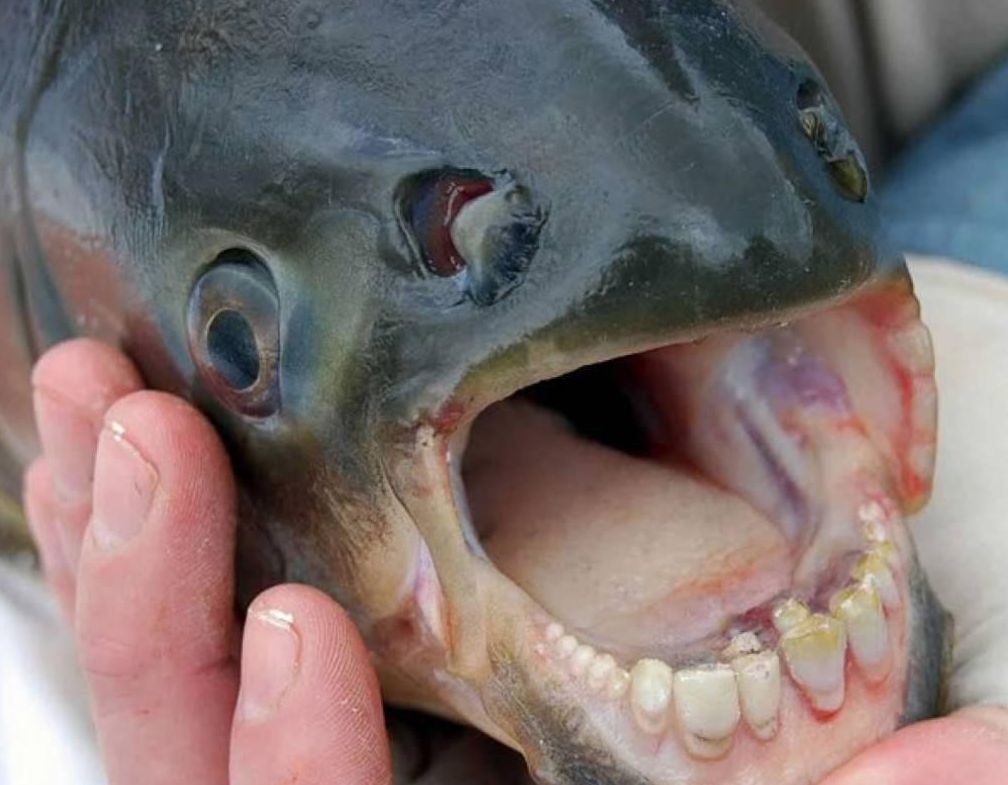
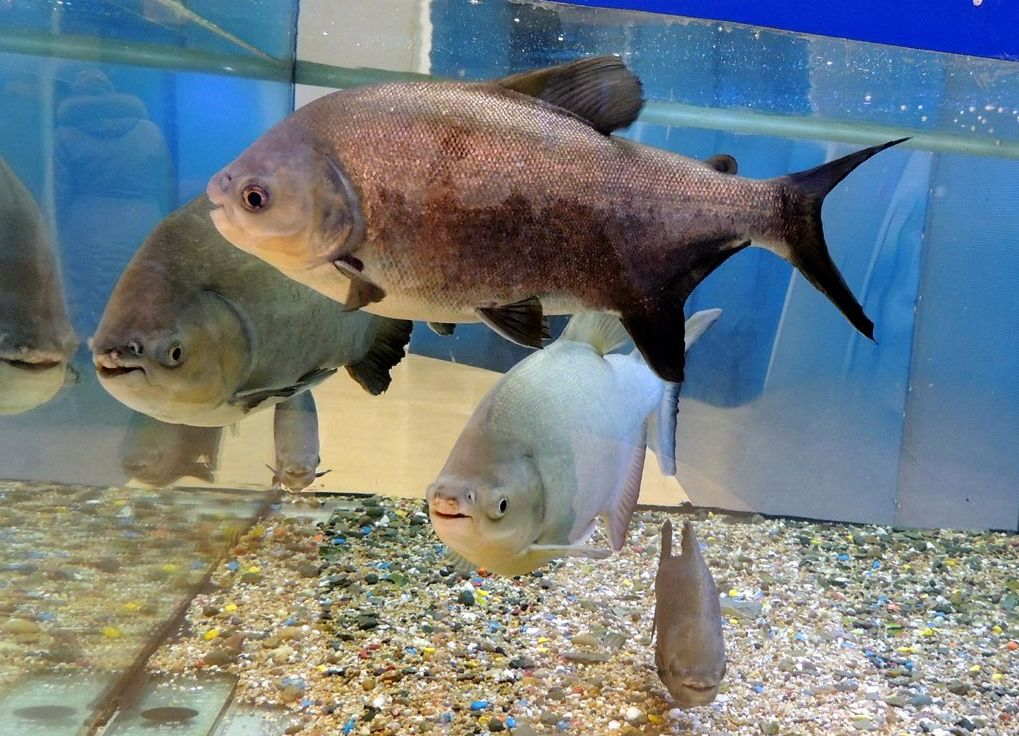
Difficulties in keeping
There are a lot of different fishes with pacu names. However, quite often, their classification is rather confusing. It is interesting, not demanding, and easy to care for and feed fish, which has its kind of intelligence.
Sounds like an ideal aquarium fish, doesn’t it?
However, the biggest problem in care is that it grows fast to become a huge fish, and rather quickly, it outgrows even very spacious tanks. The problem is that on the market, the pacu fish is quite often sold as juveniles and then mistaken for piranha. Although these fishes really look alike, pacu fish is less aggressive and not that predatory since it feeds on plant food. But it doesn’t eliminate the fact that pacu will eat any small fish in a tank without any doubt.
It’s definitely not a fish for everyone.
It is a very large fish, and it’s better to be kept in very spacious tanks – not everyone can afford to have such a fish at home, although it’s rather not demanding and easy to care about.
Provided with a proper-sized tank and good care, it can become a nice responsive pet. Nevertheless, you should be careful when keeping it in the tank. Although the fish’s diet contains mainly plant food, its strong jaws that can crack very hard seeds and nuts may bring serious danger.
Description
Size
How big do pacu get?
It is the largest Characiformes representative in South America. This is the second-largest fish after arapaima in the Amazon River basin. Pacu fish max size is about 1.1 m (3.6 ft), but usually, it’s about 0.7 m (2.3 ft) long, and it weighs up to 32.4 kg (71 lb). At that 10 % of their mass is fat.
Growth rate
How fast do pacu grow?
During the first few months of their lives, pacu fry (young pacu) can grow quite rapidly, adding several inches to their length within a short period. However, their growth rate tends to slow down as they mature.
Factors that can influence the growth rate of pacu fish include the availability of nutritious food, water quality, temperature, and tank size. Pacu fish require a balanced and appropriate diet to support healthy growth. Providing a varied diet that includes a mix of high-quality commercial pellets, fruits, vegetables, and occasional protein sources can help promote their growth.
Lifespan
How long do pacu fish live?
In ideal conditions, pacu fish can live for 10 to 15 years or even longer. However, it’s important to note that the actual lifespan of a pacu fish can be influenced by various factors, such as water quality, diet, tank size, and overall health maintenance. Providing a suitable environment, proper nutrition, and regular veterinary care can help maximize the lifespan of pacu fish in captivity.
Body and color
Its appearance resembles piranha – the body is high, laterally flattened with big eyes. The body color varies from black to gray with some variations. About 10% of the body mass is fat. The fish has square human-like teeth that make them incredibly similar to the human ones.
Pacu and piranha juveniles are very much alike. They have dark spots scattered over a silvery-steel body. Such coloring, together with a specific body shape, make the fish a pleasing object to have in a tank.
As the pacu fish grows, its appealing coloring becomes less contrast and changes from whity-brown to almost back. Its anal and pectoral fins are of the same color as the fish body. Water transparency and color affect the fish’s color intensity. In black water dyed with humic acids, such as in Rio-Negro, they have a very dark color, while in white waters, they are much lighter-colored up to having a light-golden body.
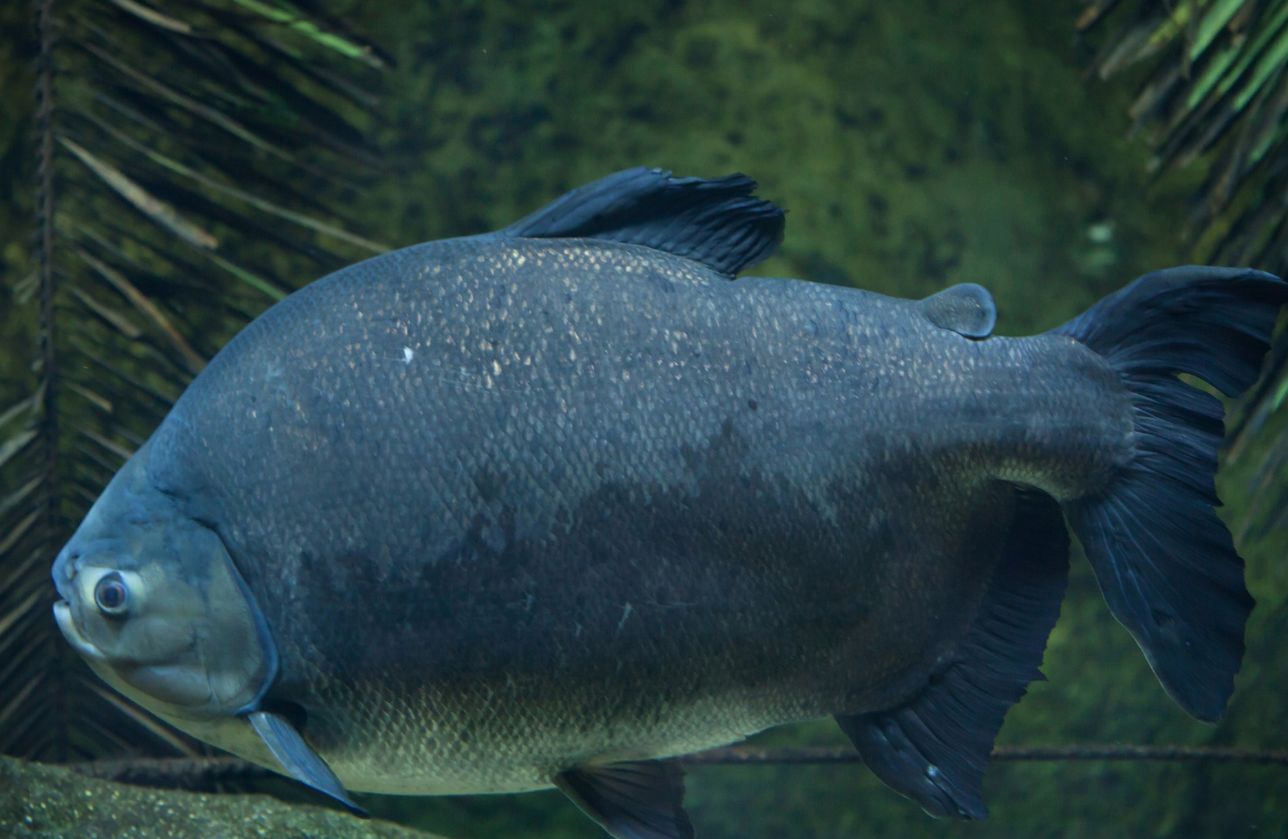
Care and keeping in a tank
Tank size
In petshops, the pacu fish is often sold as a vegetarian piranha. The juveniles are usually about 5-8 cm (2-3 in) large, but the sellers often forget to warn their potential buyers that a small-sized tank will not stop the fish from growing. As a result, these aquarists cannot create proper tank conditions for the fish and let them go to natural water bodies.
When pacu fish are small, such as a few inches in length, they can initially be kept in a smaller tank, typically around 40 to 75 gallons (150 to 280 liters). However, keep in mind that they will outgrow this tank relatively quickly.
The recommended minimum tank size for adult pacu is around 200 to 300 gallons (750 to 1,135 liters) or more. Larger tanks or ponds, such as those in the thousands of gallons, are preferable for accommodating their large size and providing ample swimming space. If you can afford such a tank – here the difficulties end, since the fish isn’t a demanding one, is not prone to diseases, and eats any food. The only thing is that they require a very strong filtration because they pollute tank water a lot.
Water parameters
The tank water temperature should be constant about 75–81°F (24–27 °C), dGH to 20°, pH about 6-8 with strong filtration, aeration, and regular water renew. Not for long, the pacu fish will do with water temperature decrease up to 22 °C. The tank water temperature of about 14-17 °C can be considered critical. This is when the fish dies.
The water you add to the tank shouldn’t contain a large amount of solution gas since the fish kind is sensitive to them. They may cause a gaseous embolism and lead to fish death.
Tank setup: decorations and plants
The pacu fish inhabits the middle water layers, and it needs some free space to swim. The best tank decorations are snags and large rocks, don’t even try to put any plants – they are feed for fish.
Fish is a bit timid – any unexpected movement causes a panic attack, and it starts swimming around the tank, hitting the objects and glass walls. If the glass isn’t sick enough, the chances are high that the fish will break it.
Diet
What do pacu fish eat? Pacu fish are primarily herbivorous, meaning their diet consists mainly of plant material.
In nature
Juveniles feed on phytoplankton, insects, snails. The adults are mainly herbivorous, and they feed on fruits and other plant food.
Black pacu gather fruit and seeds after they are ripe and fall in the water. The pacu fish eagerly eats large seeds of both dry and juicy fruit. For example, rubber tree seeds (Hevea spruceana, Euphorbiaceae) compose about 58% of the total fruit amount they eat during this time. The fruit is like a capsule that blows after it gets ripe, and its seeds fly in all directions. They are about 4 cm large and covered with a quite thick coating that only pacu’s strong teeth can crack. The fish gather under the trees waiting for the seeds to fall in the water. The second major component of the fish diet is the large fruit of Astrocaryum jauari palm tree that has the same thick coating.
In the wild, pacu fish also act as seed spreaders. They swim up to several kilometers away from the place where they swallowed the seeds. At that, the seeds get spread through the territory proper for them to grow – along the flood-plain of the rivers.
It appears that pacu, together with terrestrial animals, plays a key role in spreading seeds in the Amazon River basin. Large-sized species are the most efficient in this case since they eat more and swim farther. However, each year the number of such species in the wild decreases. Excessive fishing trade has thinned out the number of some populations at about 90%.
Considering the fish’s role in spreading tree seeds, we can assume that its extinction may lead to the tropical rain forest areas shrinkage.
In aquarium
Pacu fish is omnivorous, and in the wild, it feeds on fruit, corn, insects, snails, spineless species, and carrion. Plant food should prevail in the diet. However, the fish eagerly eats worms, blood worms, tubifex.
But too much protein leads to lipoatrophy quite fast. This is especially true for adult species since, for teens and juveniles, the proportion of protein food can be higher, about 40%. They eagerly eat pieces of tropical fruit (bananas, pineapples) and vegetables (tomatoes, pumpkin, salad, cabbage, etc.). They can even easily eat watermelon rinds.
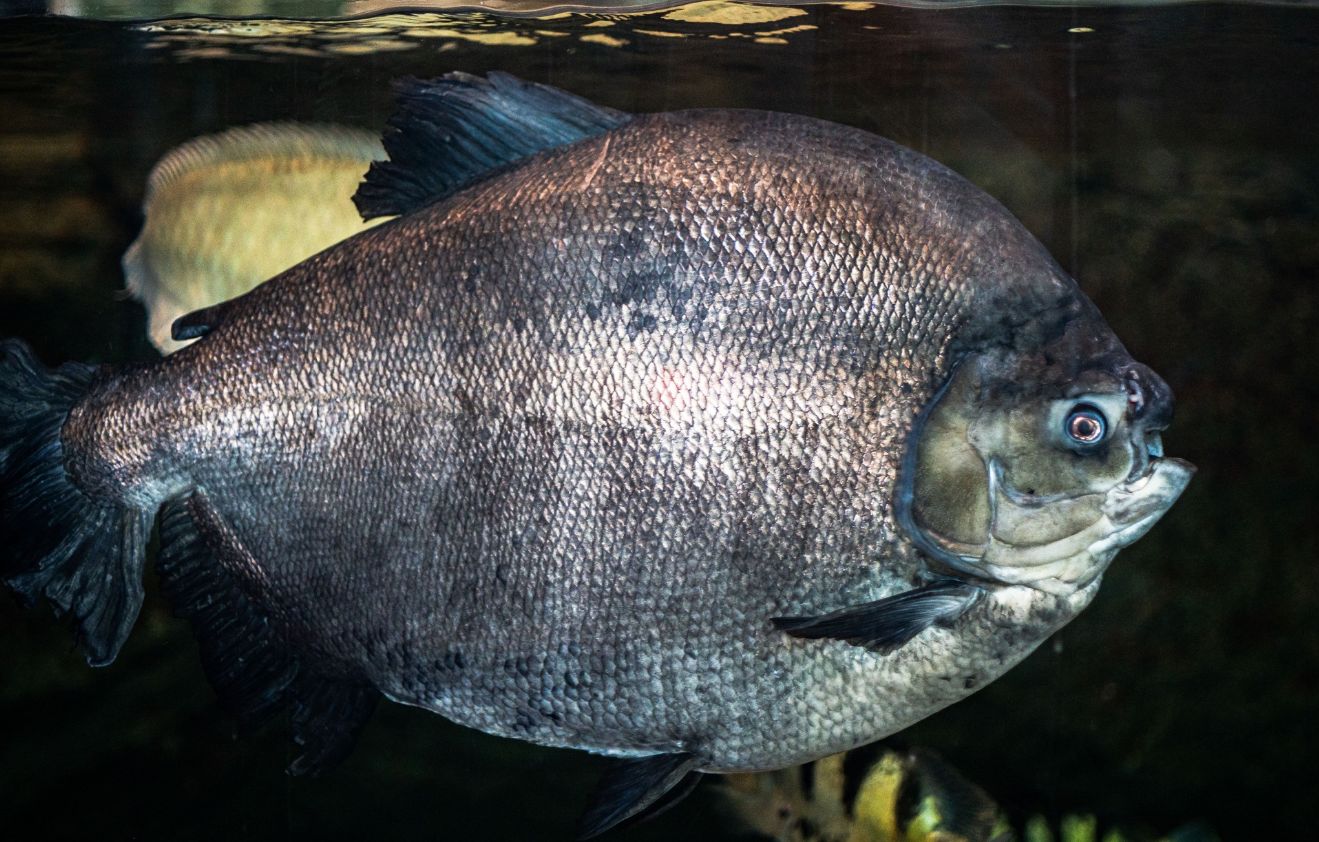
Tank mates
When considering tank mates for pacu fish, it’s important to take into account their large size, potential aggression, and specific care requirements. Pacu fish are generally peaceful toward other fish species, but their large size and active nature can pose challenges when selecting suitable tank mates.
Are pacu fish aggressive and pacu eat other fish?
Adults are loners, but they aren’t aggressive compared to their close relatives, such as piranhas. However, the juveniles are more troublesome. The adults feed on any small fish that they can swallow, but they won’t do any harm to large fishes.
Any middle and large-sized non-aggressive species will do as pacu tank mates, namely, herbivorous catfish (like sailfin pleco). It will pick up food leftovers from the tank bottom. The best tank mates for pacu are fishes of the same size (oscar fish, green terror, jaguar cichlid), or you’d better keep them alone in the tank. As for the small fishes – they are treated as food, so don’t keep pacu in a tank with them.
Consider including bottom-dwelling species that inhabit different areas of the tank to utilize the available space efficiently. Examples include plecos, large catfish species, or bottom-dwelling cichlids that are compatible with pacu fish.
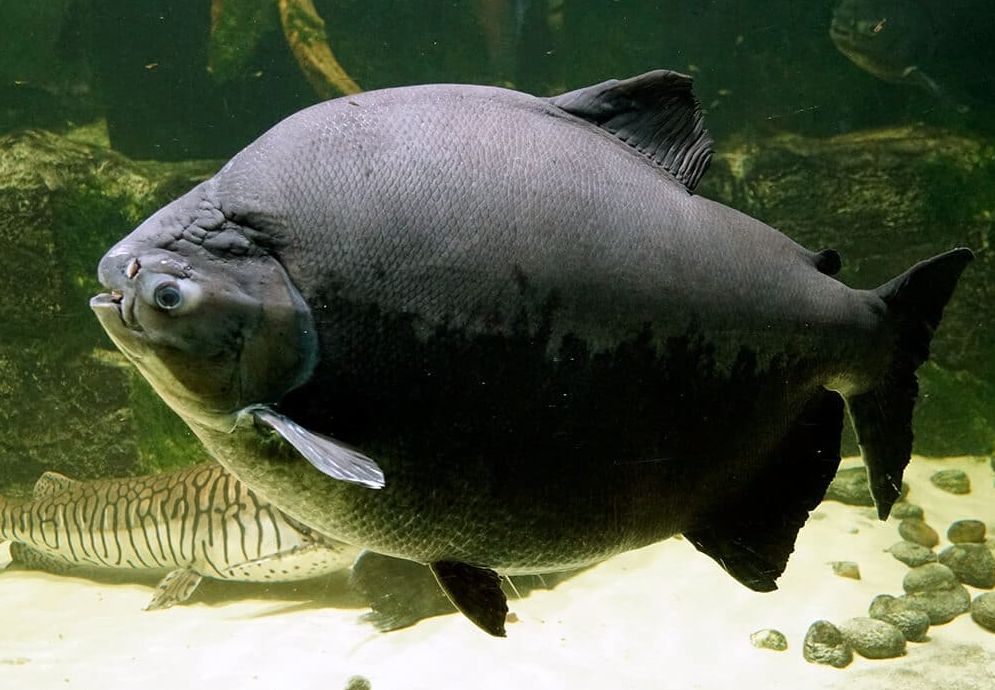
Gender differences: male vs female
Gender dimorphism is quite feeble. Reproductive females that grew in favorable conditions are significantly larger and fatter than males. The abdomen shape is a distinctive feature of pacu females. Males have a more sharp dorsal, their anal fin has pins, and the fish itself is brighter colored than its females.
Breeding
Breeding is impossible in a tank because of the fish size. All species that are on the market are bred in ponds or at farms. In the wild, usually, the fish is kept alone.
They have a seasonal spawning period that occurs during the rainy season when the water level in rivers rises high and causes water pH and hardness to decrease.
During this time, adult species gather in large schools and migrate deep into the flooded forest, where they spawn in thickly planted areas.
In the breeding industry, they take the pacu fish reproductive products and then incubate the fertilized eggs in special containers.
The females can produce from 50 to 200 thousand eggs. They stick to the substrate or scatter over the bottom. At the temperature of 26—29°C 5-7 days later, the fish larvae start to swim.
Tiny-sized plankton is their start food as well as small-grained high-quality dry food with an obligatory plant component.